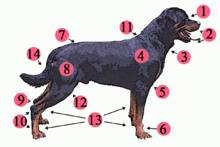I have noticed over the winter my #1 dog favouring one of his hind legs. It eventually got to
the point when he was walking or even trotting he would hold the leg up. When he worked
he would put the leg down but when we eased up the leg would come up.
Examining the leg he did not display tenderness. This included moving the leg in circles,
stretching and feeling for any abnormalities. Nothing presented so it was off to the vet for
some X-rays and expert evaluation.
What we found was there maybe (?) some damage in the stifle joint.
The stifle joint is a complex joint in the back legs. The joint is stabilized by paired
collateral ligaments which resists over-extension and inward rotation, and is the most
commonly damaged stifle ligament in dogs.
The Rx for my dog was 3 weeks of rest (a working dog?), an antiinflammatory drug. Some
omega 3 and Recovery EQ for control of chronic inflammation*. So far the treatments seem to
be working.
So how did this all start. Of course this is a very difficult question to answer. Working dogs
by their very nature and tenacity often can get themselves into difficult situation where they can
get kicked or run over. Although I did not see it, I heard it. We were digging some cattle out of
the bush and my dog either got kicked or, got run over. This is just one of the hazards of working
cattle in the bush.
*Recovery EQ is for horses. We adjust the dosage for dogs. It works just fine and is not that
different then the Recovery for dogs and is very cost effective.










